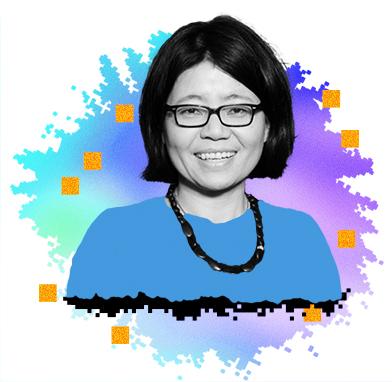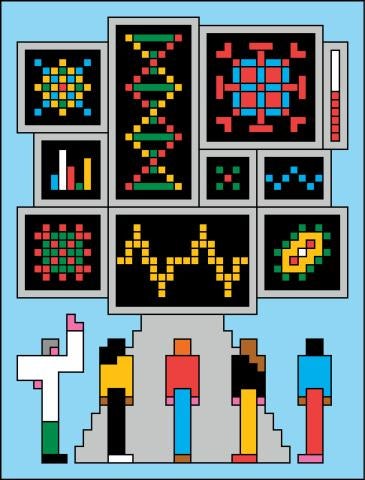
With AI, we can … Strive to predict illnesses before they start—and save lives
Cardiologists treat heart disease. Oncologists care for patients with cancer. For every disease, there is an expert specialist. But no disease exists in isolation: Biology and chemistry tangle them in intricate, enigmatic loops and webs. People with heart disease are at increased risk for dementia. Cancer treatment can damage the heart. The mechanisms behind these links, though, can fall through the cracks between medical specialties and academic disciplines.
Case Western Reserve University researchers are now developing artificial intelligence (AI) systems with the potential to transcend clinical boundaries and deliver the kind of whole-person insight that can be lost in today’s hyper-specialized systems for treatment and discovery. “A human is [an] integrated system, and [a] clinical department is [an] isolated system,” said Shuo Li, PhD, the Leonard Case, Jr. Professor in Engineering at CWRU. “We believe that one day AI will help them to do an integrated diagnosis.”
Patterns And Predictions
AI systems have a knack for recognizing patterns in images, including patterns the human eye might miss, at a volume and speed a radiologist would be hard-pressed to match, said Li, a professor of biomedical engineering and computer and data sciences, and a member of the Case Comprehensive Cancer Center’s Cancer Imaging Program.
“That has been an advantage since day one,” he said. “AI imaging is considered to be the front line of AI in healthcare.” About two-thirds of radiology departments in the United States now use AI, according to The Washington Post.
But diagnosis is just a prelude to something bigger, said Li: predicting diseases before they start.
With support from the National Institutes of Health, Li and his colleagues are developing an AI system that can make precise and individualized heart disease forecasts. The system uses a natural language model to extract key details from medical records (such as blood pressure, smoking history, heart rate and body-mass index, or BMI), then combines them with images from a low-radiation heart CT scan, leveraging deep learning and large data sets to predict not just if a patient will get sick, but, if so, when.
Many heart-disease deaths are preventable with medication or lifestyle changes. Yet it’s all too easy to tune out the constant drone of healthy-living recommendations, Li said. Predicting when a patient could be struck by a life-threatening heart event, he added, gives patients a sense of urgency: “Someone tells you, ‘in 3 1/2 years you’re going to have heart failure,’ that significantly changes a patient’s mentality.”
“AI imaging is considered to be the front line of AI in healthcare.”
—Shuo Li, professor of engineering
Li was drawn to CWRU in part by the institutional ecosystem that connects physicians, researchers and engineers, and gives them a conduit to large data sets that sustain AI. It is this interdisciplinary nexus that makes the heart-disease model possible, as Li capitalizes on a deep library of electronic health records and specialized heart scans, called calcium scoring CT scans.
University Hospitals began offering calcium scoring CT scans at no cost in 2016 to empower patients by providing them with a quick, non-invasive measure of their heart health, said Sanjay Rajagopalan, MD, a professor and director of the Cardiovascular Research Institute at Case Western Reserve University School of Medicine, who spearheaded the program with others, including colleagues in radiology. Today, more than 160,000 patients in Ohio and other parts of the United States have gotten such scans, leading to the creation of the world’s largest repository of its kind, Rajagopalan said.
Still, such imaging is just one facet of information about a patient’s overall health, Rajagopalan said.
“A substantial portion of your risk [for cardiovascular disease] comes from the environment,” he said, describing factors including diet, exercise, social relationships, time spent in nature and early trauma.
He imagines a not-so-far-away future in which an AI algorithm will gather all of this information to allow derivation of more accurate heart disease risk predictions that may then facilitate personalized, heart-healthy lifestyle plans. “We need solutions that are more holistic,” said Rajagopalan, also chief of cardiovascular medicine and chief academic and scientific officer at University Hospitals Harrington Heart and Vascular Institute.
From diagnosis to discovery
Rong Xu, PhD (GRS ’99, biology), director of the Center for Artificial Intelligence in Drug Discovery at the CWRU medical school, is also using AI to break down boundaries between disciplines with a different goal: gaining biomedical insight.
“In biomedical discovery, you want to find something novel and unexpected. The typical data-driven black-box machine learning and deep learning won’t work for these kinds of open questions,” said Xu, also a professor of biomedical informatics. “We’re trying to build a system to simulate how we as scientists come up with new hypotheses.”

Human researchers might start in the library, reading papers and trying to connect the dots in a way that leads to a new revelation. But today that’s practically impossible: The National Library of Medicine already contains some 38 million papers published in the last 50 years, and more than 1.5 million new biomedicine and life sciences papers are published annually.
No human could absorb it all—but the task comes naturally to AI. So Xu’s team uses AI tools to build a version of the ever-growing library of scientific publishing that is an “AI knowledge center” containing biomedical knowledge extracted from those tens of millions of research papers, hundreds of millions of patient electronic health records, plus data on genetics, disease pathways, existing drugs and chemical compounds. Xu and her colleagues then created an AI algorithm that could “ingest” all that information and use it to reason like a scientist.
The system may think like a scientist, but it can’t replace one, said Xu. For one thing, human researchers have to come up with questions to feed into the system. And, crucially, humans must judge whether the AI conclusions make sense, then do the hands-on research to see whether they hold up in the real world.
In 2024, for example, Xu and colleagues examined millions of patient electronic health records to test the hypothesis that semaglutide, the active ingredient in popular diabetes and weight-loss drugs, could be used to treat substance use disorders. Then, they used AI to spotlight possible biological mechanisms underlying the links. Based in part on these results, the National Institutes of Health launched a clinical trial of similar drugs to help people with substance use disorders, bypassing typically required laboratory studies.
Xu, also a member of the cancer genomics and epigenomics program at the Case Comprehensive Cancer Center, is collaborating with the center’s director, Gary Schwartz, MD, to identify new drug candidates for Ewing sarcoma, a rare cancer most common in children and young adults.
In just one day, the AI system was able to winnow a list of 5 million compounds down to five with potential to treat the disease. It still took months for the researchers to test the compounds to find what worked best—and plenty of work remains before a drug might be considered for a clinical trial. But AI dramatically sped up the initial hunt.
“AI can ingest all the knowledge we have published so far, including disease genetic pathways, and bring those specialties together,” Xu said. It “can help to connect dots.”
Illustration by Mathieu Lacrecque
Research Impact


